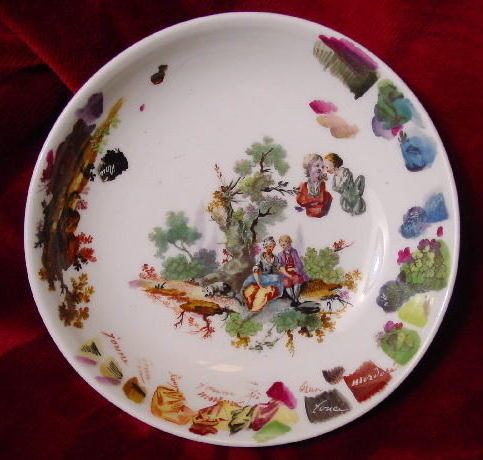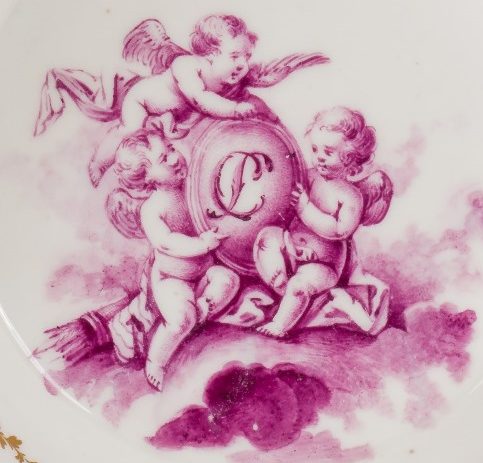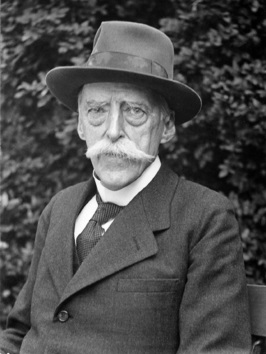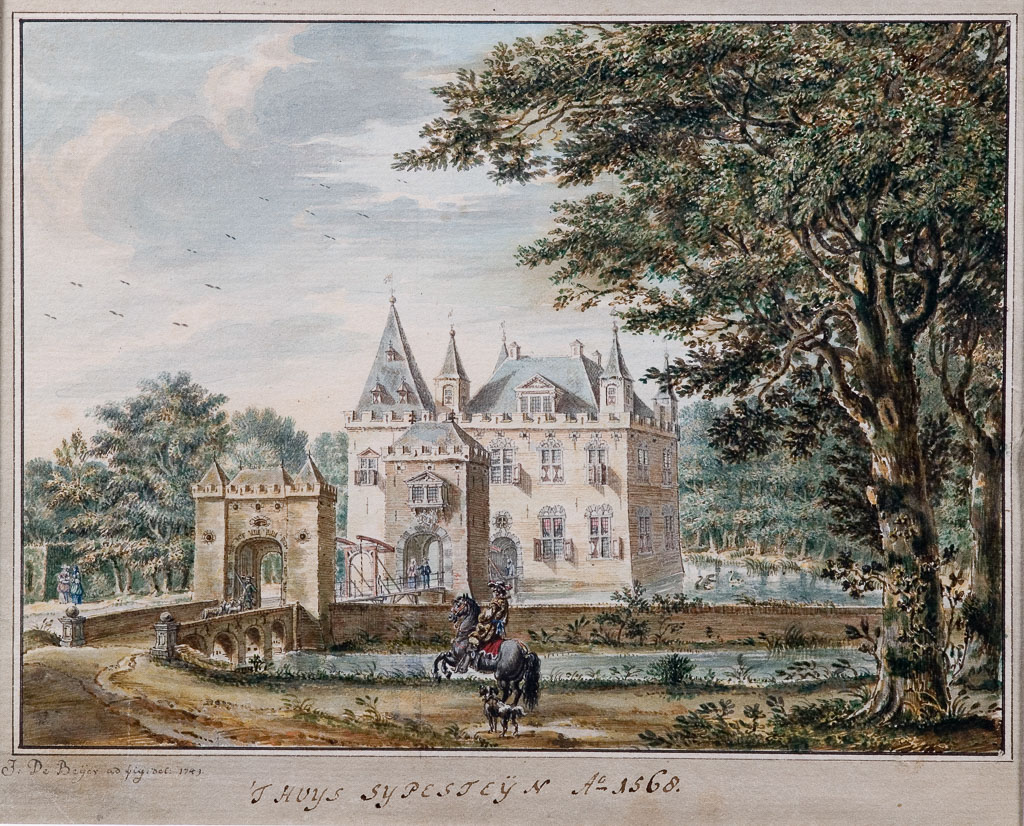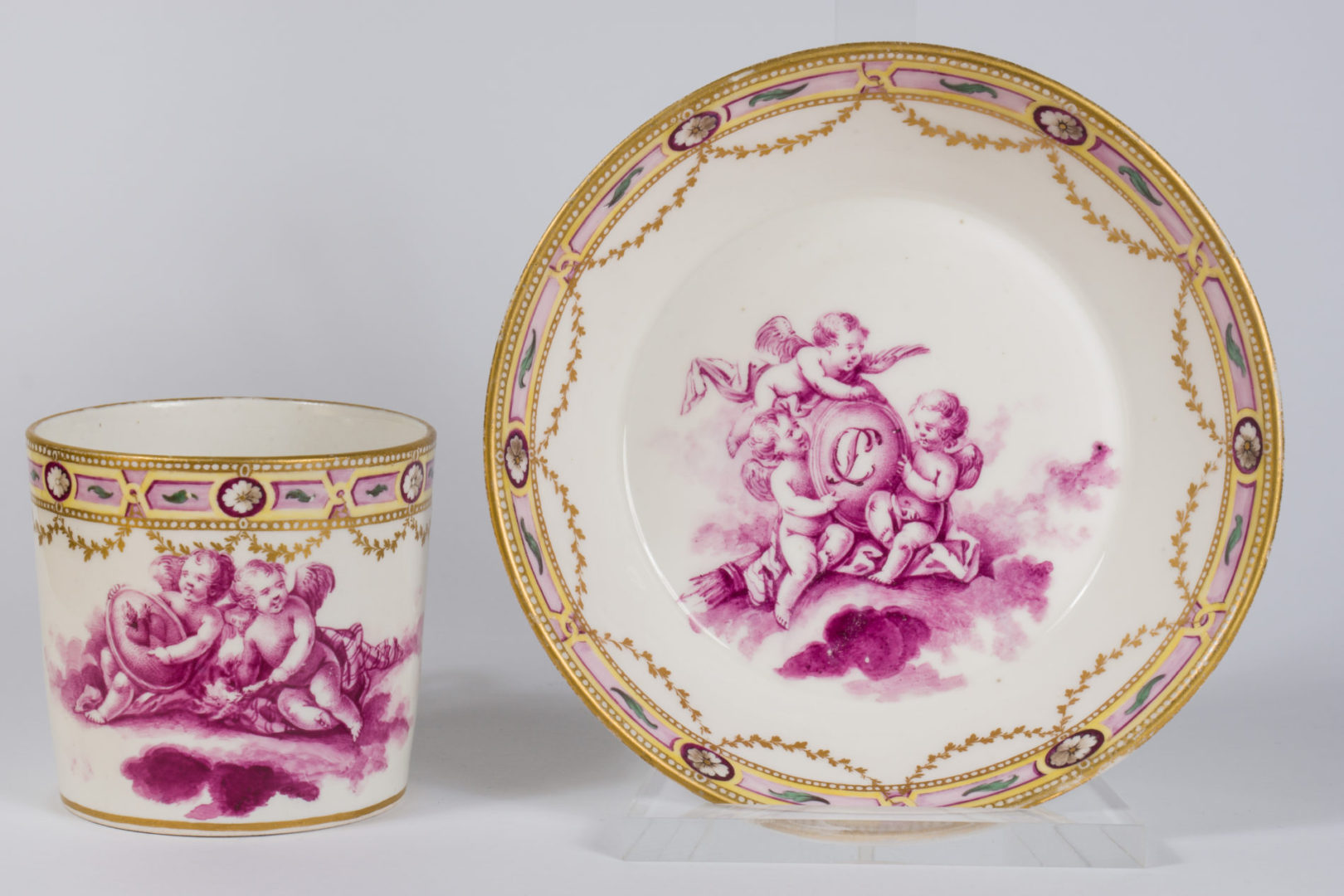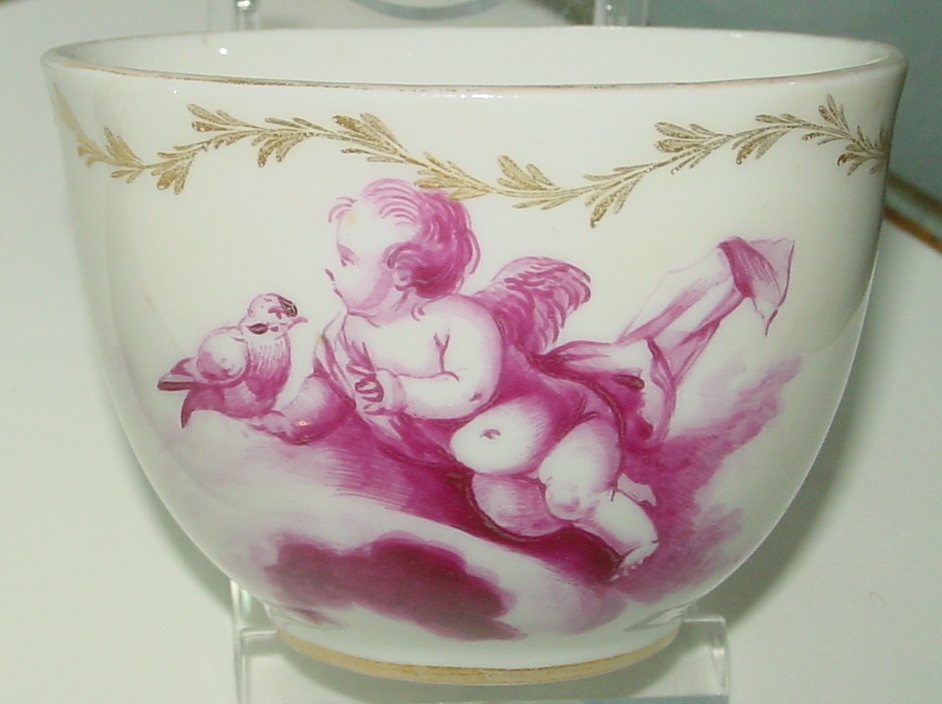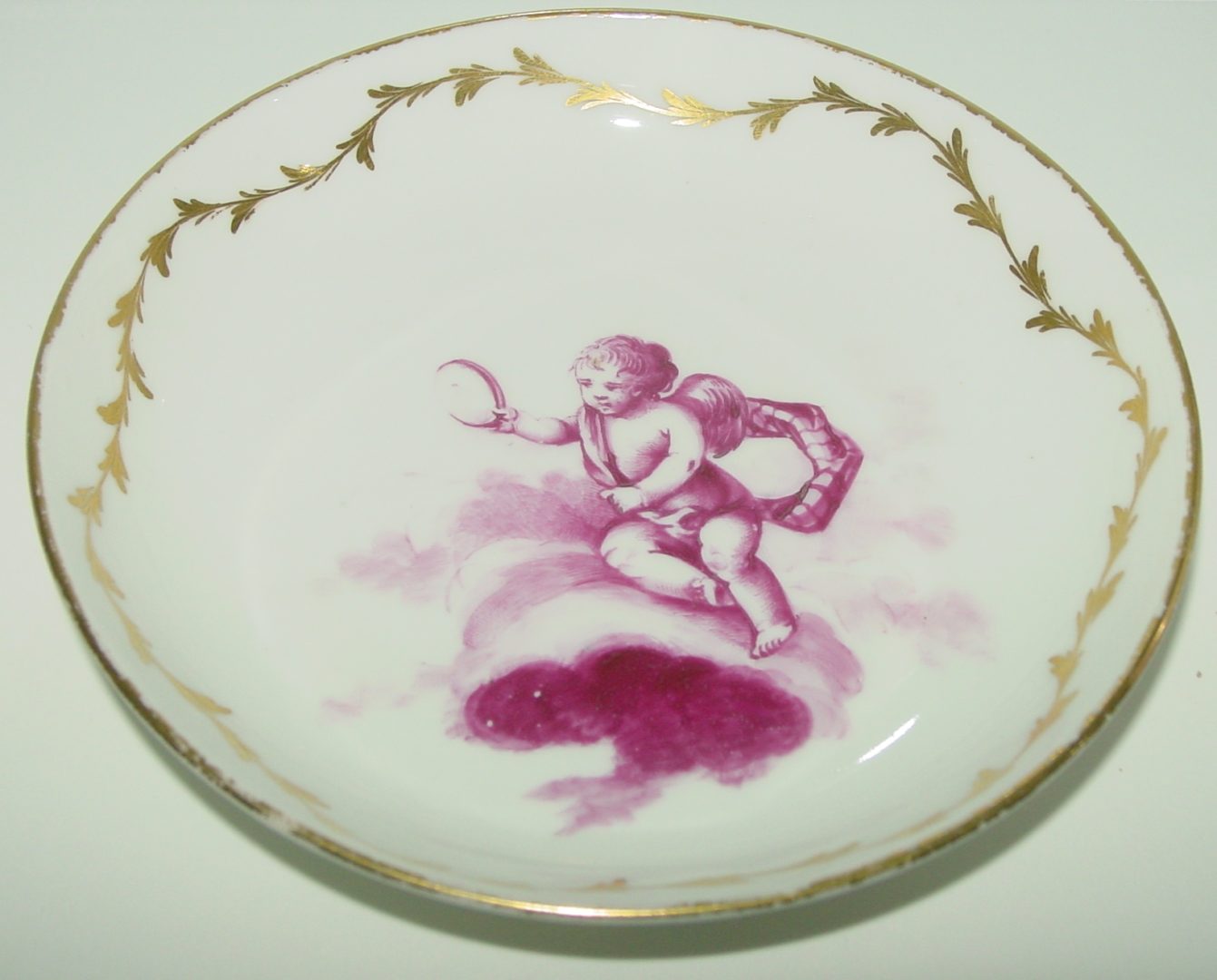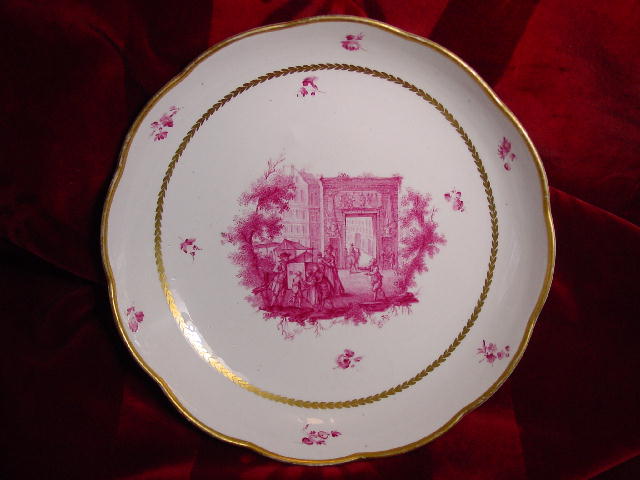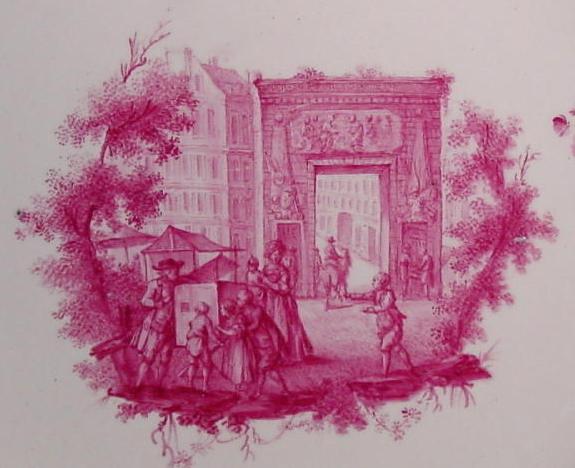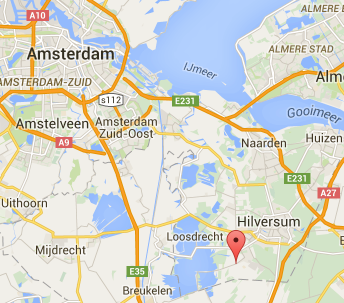1 A Loosdrecht porcelain color-trial saucer painted by Duvivier, c. 1783, with color patches on the edge around a center scene in a forest. Marked “M.O.L.” above a star in underglaze blue on the base. Diam. 12.9 cm. (Inv. 8908). Photo by the author.
5b Detail of a Loosdrecht porcelain saucer from a friendship cup and saucer set (see 5a) with putti in puce by Duvivier, c. 1783. Marked with “M.O.L.” in under-glaze blue on the base. (Inv. 8557-40b). Photo by the author.
Fidelle Duvivier worked at the Loosdrecht porcelain manufactory as a decorator in the period
c. 1780-84, after having been employed in France at the Sceaux manufactory near Paris. Loosdrecht had begun production in 1775 and its founder, Rev. Joannes de Mol, employed a great number of skilled hands from other countries to carry out most of the main tasks of porcelain manufacture and decoration. Each newly hired painter would have tested his enamel colors and techniques on some “trial” piece of porcelain (a cup or small plate), and what we see in (1) is such a piece – painted by Duvivier. Along the edge are the names of various colors written in French above or scratched into the color patches.(i) This rare specimen, along with other intriguing pieces with his decoration, can be seen in the collections of a Dutch castle located in Nieuw-Loosdrecht, Kasteel-Museum Sypesteyn (2), about ten minutes from the site of the porcelain manufactory in Oud-Loosdrecht.
2 Kasteel-Museum Sypesteyn in Nieuw-Loosdrecht, the Netherlands
This castle, one of the youngest in the Netherlands, was built between 1912 and 1922 by the nobleman (jonkheer) C.H.C.A. (Henri) van Sypesteyn (3), a passionate collector and historian who knew of his family’s centuries-old connections to this region and Loosdrecht. Family tradition said that the Van Sypesteyn family had lived in a 16th-century castle that had once stood on the present-day site of the Kasteel. When the nobleman arrived in Loosdrecht in 1884 to investigate his family’s past, he succeeded in purchasing the land in question and began looking for the foundations of the former castle, a late-medieval manor house said to have been demolished in about 1580. He was also guided by an 18th-century drawing in his possession (4), which he believed showed the original appearance of the family castle.
Since the jonkheer Catharinus Henri Cornelis Ascanius van Sypesteyn (to use his full name) never married and was the last surviving male descendant of his family, he wished to honor his forefathers by recreating the family estate. At the same time it would be a fitting home for his art collections and family treasures which he wished to share with the public. He established a family foundation in 1902, and beginning in 1912, the castle was erected using as much original 17th-century material as possible, such as doors, staircases and fireplaces, which had been bought up at demolition sites. His goal was to keep the general style to that of around 1600 (although much older materials were sometimes used). The former park and gardens, designed in keeping with the period as well, were intended to contribute to the illusion that all was just as it used to be.(ii)
3 C.H.C.A. van Sypesteyn (1857-1937) in a photo dated c. 1930.
4 Van Sypesteyn believed that this 18th-century drawing depicted his ancestors’ original castle. ” ‘T Huys Sypesteyn Anno 1568” by Jan de Beyer and dated 1743.
Van Sypesteyn also collected porcelain and was keenly interested in the history and production of Rev. de Mol’s local porcelain manufactory. Nearly all of the Duvivier pieces shown here came to the museum later, after the jonkheer’s death, except for the cup and saucer in (5a), which he himself acquired for his collection in 1911.
This exquisite Loosdrecht friendship cup with saucer (5a,b) is decorated with a neoclassical border design surrounding two groups of putti (cupids) on clouds. These little winged beings hold emblems of love and friendship – a shield with two flaming hearts and burning torches with a quiver of arrows nearby, and on the saucer they hold another shield with the initials “C. S.” This may have been either a commissioned piece or a gift from Duvivier to a person with these initials. On the base of each piece is the French inscription, “SOUVENIR DE L’AMITIÉ.”(iii)
5a A Loosdrecht porcelain friendship cup and saucer set with putti in puce monochrome by Duvivier, framed by a neoclassical border design. Both pieces marked “M.O.L.” in underglaze blue. H cup 7.1 cm, Diam. of saucer 14.5 cm. (Inv. 8557-40 a,b). Photo: Kasteel-Museum Sypesteyn.
6a,b A Loosdrecht porcelain cup and saucer with putti in puce monochrome by Duvivier. Other pieces of this service are illustrated in Footsteps, pp. 66-67.
H cup 4.6 cm, Diam. of saucer 13.2 cm. (Inv. 9074-a,b). Photos by the author.
Another cup and saucer (6a,b) decorated with similar putti on clouds belonged to a charming and now widely-dispersed coffee service, some pieces of which are illustrated in my other Duvivier articles and the Duvivier book.
7a A Loosdrecht porcelain deep plate decorated in puce monochrome by Duvivier, with gilding on the edge and a band of gilded leaves around a central scene (6b). Marked M.O.L. with a star beneath in underglaze blue on the reverse. Diam. 20 cm. (Inv. 8922).
7b A detail of the central decoration on the plate at left, which shows a scene at a market with children looking into a peepshow device at specially colored engravings of distant countries, world wonders, and historical events. As they looked, the traveling showman would recite rhymes and stories about these exotic places.
Photos by the author.
The Loosdrecht deep plate shown in 7a,b illustrates a popular entertainment for young and old at fairs and public places in villages and towns across Europe during the eighteenth century – the peepshow man with his box (in Dutch: rarekiek). This model would have been fitted with a mirror and special lenses so the children looking into the box would have been gazing at engraved scenes with an almost 3-D effect. Other models came to be known by the name Magic Lantern.
In the background we see a rider on horseback approaching what appears to be an arc de triomphe with tall residential buildings beyond it. Since there were no such arches in the Netherlands, it has been suggested that this one somewhat resembles the triumphal arch Saint Denis in Paris. If that is correct, Fidelle chose to include a landmark he remembered from his time in France at Sceaux near Paris. As I mentioned in my book, he painted a similar peepbox scene on another Loosdrecht dinner plate (in Kasteel Duivenvoorde). Documents more recently discovered in England revealed that he left Staffordshire for America (after 1796) and was reported to have been involved in such a magic lantern show.(iv)
NOTES
(i) See also Blogpost 4 of January, 2017 for traces of his unmistakable style of decoration on a few sherds recovered from Loosdrecht excavations, as well as Charlotte Jacob-Hanson, “Fidelle Duvivier in France and the Netherlands,” The Magazine Antiques 169, no. 1 (January 2006), pp. 168–77; and “Fidelle Duvivier: Tracing the Career of a Porcelain Painter,” Vormen uit Vuur, vol. 199, 2007/4, pp. 37-45, both posted at www.academia.edu
(ii) There was a movement at the end of the nineteenth century when the genre of the Dutch collector’s house-museum was evolving, and such efforts to recreate ancestral castles as the jonkheer was undertaking were being repeated elsewhere in the Netherlands. He realized his desire to recreate a Dutch manor house as it could have existed around 1600, with as many original elements as possible, but contrary to his expectations, the foundations on the property proved to be those of a 16th-century farmhouse, not a castle. And as for finding the desired historical documentation to confirm long-held traditions about his family, he had little success. “Although the Van Sypesteyn family claims to originate from the medieval noble house of the same name, which was honored by Count Floris V in the thirteenth century, this cannot be documented. The family was, in fact, ennobled only in 1815.” – see Helen Wüstefeld, “Sypesteyn: a Collector’s House Museum,” at the following link:
https://www.codart.nl/images/CODART%20NEGEN%20congress_Text%2010%20Helen%20Wstefeld.pdf
and Conny Bogaard, “Sypesteyn Castle: A Special Kind of Collector’s House in The Netherlands,” Open Museum Journal, Volume 5 (July 2002).
(iii) See Charlotte Jacob-Hanson, In the Footsteps of Fidelle Duvivier (Tucson, Arizona: West Press, 2016), p. 69.
(iv) Ibid., pp. 72-74.
Kasteel-Museum Sypesteyn has been a museum since 1926. It is open from March through October. See www.sypesteyn.nl .
8 Location of Loosdrecht and Kasteel-Museum Sypesteyn

